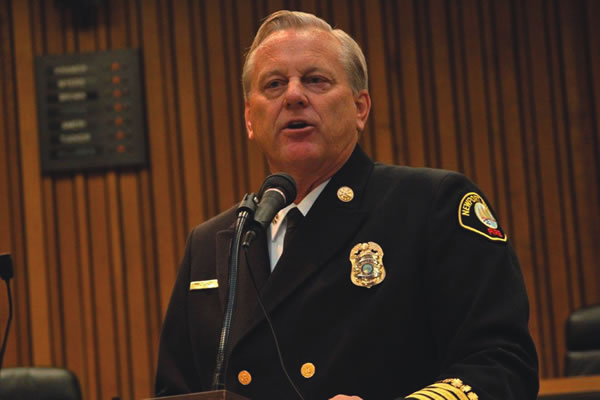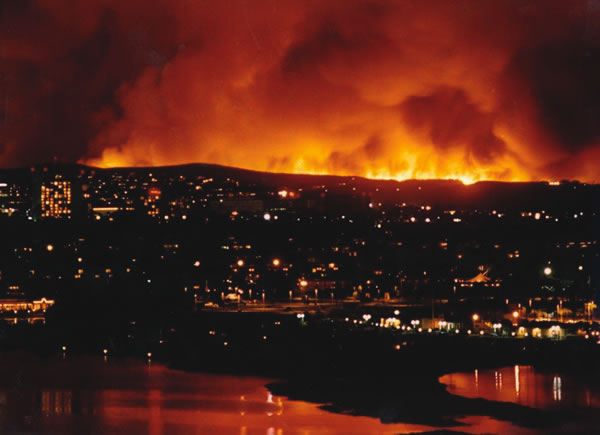Preparing for Wildfire
By Gina Dostler
Whenever the Santa Ana winds blow, they sweep in the potential for wildfires. Most fires ignite due to human interaction, whether intentional or by accident, rather than from nature’s lightning strikes. Since the coastal hills remain prone to wildfires, prevention is the key to avoid runaway wildfires, Kevin Kitch, assistant chief of the Newport Beach Fire Department, explains.
Q: What are some things we have learned about wildfires in our area?
A: For decades we’ve known the hills in our area have a natural ecology that burns. It’s a necessary part of the environment. The Santa Ana’s blow in and with it the potential for fire. Even the Spaniards noted a lot of fires here, meaning fires have been going on for centuries. And though fire fighting has come a long way and we do a great job suppressing fires, we first have to understand our environment and fire ecology in order to help keep wildfires at a minimum. We want to reduce the risk.
Q: How do know if I have to worry about wildfires?
A: If your home borders a natural area, what firefighters call the wildland urban interface, you are at risk from a wildfire. And, if you live within one mile of a natural area, you live in the ember zone. Homes in the ember zone are at risk from wind-driven embers from a wildfire.
Q: How can we be proactive?
A: As a community, fuel reduction has been a very proactive force in the hills such as in Newport Coast. Planting the right types of species on the hills, keeping the density low and keeping them away from structures is a smart way this community has designed its landscapes. But what we have been focusing on is a three-prong approach: education, engineering, enforcement.
Q: You teach about fires?
A: Simply put it is education on what to do and what not to do for fire prevention. Many people new to the area are not aware of our Santa Ana’s, and despite the wind, light a recreational fire causing embers to fly with the potential to land and ignite some dry leaves, brush, etc. Our wildland fire safety information in our Ready! Set! Go brochure helps you prepare your home and family in case of a wildfire. It can be found on our website or by calling 949-644-3110 for copies.
Q: Engineering?
A: Building structures that don’t burn, or engineering ignition resistant building standards. It’s not fire proof. It’s ignition resistant. New homes are usually already outfitted with concrete tiles on the roofs, stucco exterior and sprinkler systems inside. Building any structure to resist wildfires is our second approach to keeping fire from burning. There are ignition resistant building codes in areas prone to wildfires to keep this second prong, engineering, in effect.
Q: And the third prong, enforcement?
A: To ensure that the fuel is reduced. There are fuel modification zones where the native chaparral species once ignited burn hot, especially in a canyon. We make sure to reduce it significantly and in some cases, replant the area with other native species that don’t carry the same fuel load and are drought tolerant to help stabilize the soil. We can’t clear off all the brush because erosion occurs, which translates to water quality issues that run-off into the ocean. We are very careful and smart not to open doors to other problems.
Q: What are some household prevention tips?
A: This is a time for leaves to drop so clear off gutters, eaves, porches and decks. One tiny ember from a wildfire can ignite the dead vegetation. Keep firewood 30 feet away from the house if you can. And make sure the attic vent is covered with at least a wire mesh that has 1/8wide wire spacing or another cover that is more effective in preventing embers from flying into the attic. Check the roof. It just takes one loose tile to null and void the protection provided by the whole assembly of the roof.
Q: What about landscaping for the home?
A: Keep plants healthy. Most people tend to over-water which can lead to erosion. Planting with native species is beneficial for this area. Once a native is established, little attention is needed. And they are drought resistant, resist fire and stay small to keep fuel load low. There are even some native species you shouldn’t plant. For instance, you really don’t want a sumac that can grow up to 10 feet tall growing near your home. It burns really hot and carries a high fuel load. We have a list of species that are good to plant on the city of Newport Beach website.
Q: Some other things to think about?
A: You should always know two ways out of your neighborhood. Be ready to go; have your important documents ready where you can grab, prescription medications in one place, your reading glasses and other items. Make a phone list of people you can call that are not in your immediate neighborhood and can keep a line of communication open. Be ready and understand when the flaming front comes in your neighborhood, it doesn’t catch you by surprise. All residents of this community should be signed up with Alert OC (www.alertoc.com). It’s a type of reverse 911 that allows us to reach out to the community via text, email or phone with good, accurate and timely information during an emergency.
CONTACT INFORMATION
Kevin Kitch, Assistant Fire Chief
Newport Beach Fire Department
100 Civic Center Drive
Newport Beach, CA 92660
949-644-3104
http://www.newportbeachca.gov/
Photo courtesy NB Fire Department
The 1993 wildland fire that began in Laguna Beach and raced north across brushlands toward’s Irvine and Newport Beach.





